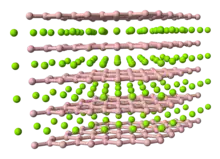Tantalum boride
Tantalum borides are compounds of tantalum and boron most remarkable for their extreme hardness.


Properties
The Vickers hardness of TaB and TaB2 films and crystals is ~30 GPa.[1][2][3] Those materials are stable to oxidation below 700 °C and to acid corrosion.[1][3]
TaB2 has the same hexagonal structure as most diborides (AlB2, MgB2, etc.).[4] The mentioned borides have the following space groups: TaB (orthorhombic, Thallium(I) iodide-type, Cmcm), Ta5B6 (Cmmm), Ta3B4 (Immm), TaB2 (hexagonal, aluminum diboride-type, P6/mmm).[3]
Preparation
Single crystals of TaB, Ta5B6, Ta3B4 or TaB2 (about 1 cm diameter, 6 cm length) can be produced by the floating zone method.[2][3]
Tantalum boride films can be deposited from a gas mixture of TaCl5-BCl3-H2-Ar in the temperature range 540–800 °C. TaB2 (single-phase) is deposited at a source gas flow ratio (BCl3/TaCl5) of six and a temperature above 600 °C. TaB (single-phase) is deposited at BCl3/TaCl5 = 2–4 and T = 600–700 °C.[1]
Nanocrystals of TaB2 were successfully synthesized by the reduction of Ta2O5 with NaBH4 using a molar ratio M:B of 1:4 at 700-900 °C for 30 min under argon flow.[5]
- Ta2O5 + 6.5 NaBH4 → 2 TaB2 + 4 Na(g,l) + 2.5 NaBO2+ 13 H2(g)
References
- Motojima, Seiji; Kito, Kazuhito; Sugiyama, Kohzo (1982). "Low-temperature deposition of TaB and TaB2 by chemical vapor deposition". Journal of Nuclear Materials. Elsevier BV. 105 (2–3): 262–268. Bibcode:1982JNuM..105..262M. doi:10.1016/0022-3115(82)90383-x. ISSN 0022-3115.
- Otani, S; Korsukova, M.M; Mitsuhashi, T (1998). "Floating zone growth and high-temperature hardness of NbB2 and TaB2 single crystals". Journal of Crystal Growth. Elsevier BV. 194 (3–4): 430–433. Bibcode:1998JCrGr.194..430O. doi:10.1016/s0022-0248(98)00691-5. ISSN 0022-0248.
- Okada, Shigeru; Kudou, Kunio; Higashi, Iwarni; Lundström, Torsten (1993). "Single crystals of TaB, Ta5B6, Ta3B4 and TAB2, as obtained from high-temperature metal solutions, and their properties". Journal of Crystal Growth. Elsevier BV. 128 (1–4): 1120–1124. Bibcode:1993JCrGr.128.1120O. doi:10.1016/s0022-0248(07)80109-6. ISSN 0022-0248.
- Chen, Xing-Qiu; Fu, C. L.; Krčmar, M.; Painter, G. S. (2008-05-16). "Electronic and Structural Origin of Ultraincompressibility of5dTransition-Metal DiboridesMB2(M=W, Re, Os)". Physical Review Letters. American Physical Society (APS). 100 (19): 196403. Bibcode:2008PhRvL.100s6403C. doi:10.1103/physrevlett.100.196403. ISSN 0031-9007. PMID 18518467.
- Zoli, Luca; Galizia, Pietro; Silvestroni, Laura; Sciti, Diletta (23 January 2018). "Synthesis of group IV and V metal diboride nanocrystals via borothermal reduction with sodium borohydride". Journal of the American Ceramic Society. 101 (6): 2627–2637. doi:10.1111/jace.15401.